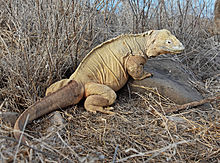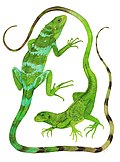Conolophus pallidus
| Santa Fe land iguana | |
|---|---|

| |
| Scientific classification | |
| Domain: | Eukaryota |
| Kingdom: | Animalia |
| Phylum: | Chordata |
| Class: | Reptilia |
| Order: | Squamata |
| Suborder: | Iguania |
| Family: | Iguanidae |
| Genus: | Conolophus |
| Species: | C. pallidus
|
| Binomial name | |
| Conolophus pallidus Heller, 1903
| |
Conolophus pallidus (the Santa Fe land iguana or Barrington land iguana) is a species of lizard in the family Iguanidae. It is one of three species in the genus Conolophus and is endemic to Santa Fe Island in the Galapagos.[3][4]
Taxonomy[edit]
The species was first described by American zoologist Edmund Heller in 1903. Some authorities have questioned whether C. pallidus is a valid species in its own right or merely a variant or subspecies of the Galapagos land iguana found on other islands in the Galapagos.[5]
Etymology[edit]
Its specific name, pallidus, is Latin for "pale", denoting its lighter coloration than C. subcristatus.
Morphology[edit]
The Santa Fe land iguana is similar to the Galapagos land iguana except that the Santa Fe land iguana is paler yellow with a longer more tapered snout and more pronounced dorsal spines.[3]
The Santa Fe land iguana grows to a total length (including tail) of 0.91 m (3 ft) with a body weight of up to 11 kg (25 lb).[6] Being cold-blooded, it absorbs heat from the sun basking on volcanic rocks and at night sleep in burrows to conserve its body heat.[6] These iguanas also enjoy a symbiotic relationship with the island's finches; the birds remove parasites and ticks, providing relief to the iguana and food for the birds.[3][7]
Diet[edit]
Santa Fe land iguanas are primarily herbivorous, however some individuals have shown that they are opportunistic carnivores supplementing their diet with insects, centipedes and carrion.[3] Because fresh water is scarce on the islands they inhabit, land iguanas obtain the majority of their moisture from the prickly-pear cactus that makes up 80% of its diet: fruit, flowers, pads, and even spines.[3][6] During the rainy season they will drink from available standing pools of water and feast on yellow flowers of the genus Portulaca.[6][7]
References[edit]
- ^ Gentile, G.; Grant, T.D. (2020). "Conolophus pallidus". IUCN Red List of Threatened Species. 2020: e.T5239A3014028. doi:10.2305/IUCN.UK.2020-2.RLTS.T5239A3014028.en. Retrieved 16 November 2021.
- ^ "Appendices | CITES". cites.org. Retrieved 2022-01-14.
- ^ a b c d e Freda (2006). "Land iguanas" (PDF). Charles Darwin Research Station Fact Sheet. Charles Darwin Foundation for the Galapagos Islands. Archived from the original (PDF) on 2007-06-06. Retrieved 2007-10-14.
- ^ World Conservation Monitoring Centre (1996). "Conolophus pallidus". IUCN Red List of Threatened Species. 1996: e.T5239A11121073. doi:10.2305/IUCN.UK.1996.RLTS.T5239A11121073.en.
- ^ Rassmann, Kornelia; Markmann, Melanie; Trillmich, Fritz; Tautz, Diethard (2004), "Tracing the Evolution of the Galapagos Iguanasn", Iguanas: Biology and Conservation, California: University of California Press, pp. 71–83, ISBN 978-0-520-23854-1
- ^ a b c d Rogers, Barbara (1990), Galapagos, New York: Mallard Press, p. 51, ISBN 978-0-7924-5192-1
- ^ a b Kricher, John (2006), Galapagos: A Natural History, New Jersey: Princeton University Press, pp. 9, 51, 91, 200, ISBN 978-0-691-12633-3


